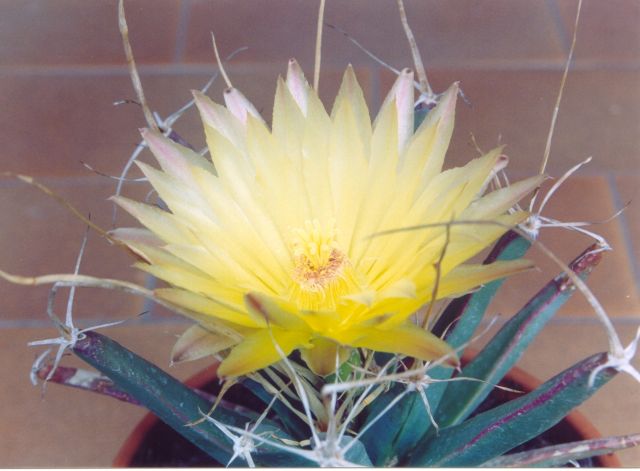- Cacteae
image_caption="Leuchtenbergia principis " flower
regnum =Plant ae
divisio = Magnoliophyta
classis = Magnoliopsida
ordo =Caryophyllales
familia = Cactaceae
subfamilia =Cactoideae
tribus = Cacteae
subdivision_ranks = Sub-tribes
subdivision =Cactanae Cactinae Cereinae Echinocactinae Echinocereinae Epiphyllinae Hylocereinae Rhipsalidinae Cacteae is a tribe of
plants belonging to the family Cactaceae. They consist of species that either have noleaves at all, or have stems that resemble leaves. Some have scales that resemble leaves, but the majority have leaf-bases that have been fused either into ribs ortubercles .The Cacteae tribe is very large, comprising almost 75% of all the Cactaceae. As a result it has been sub-divided into eight sub-tribes, these being as follows: Cactanae, Cactinae, Cereinae, Echinocactinae, Echinocereinae, Epiphyllinae, Hylocereinae, and Rhipsalidinae. Members of this tribe have been moved around and often placed in other tribes. So the taxonomy below is quite inaccurate and needs revised.
Cactanae
Similar to Echinocactinae, these plants tend to have either globular or stumpy cylindrical main stems. They don't branch, but may produce offshoots from the base. They have ribs that are fused together tubercles, so much so that there is only a vague bump where the areoles are. The plants also develop a pronounced, wooly, and occasionally bristly cephalium from which the flowers appear. There are only two genera comprising this subtribe, Disocactus and Melocactus.
Cactinae
This is quite an important subtribe, especially to cacti-lovers, as it contains the large Mamillaria genus. This may not be as large as the Opuntia genus but it contains more that its fair share of hybrids and variations - sometimes making it near impossible to determine the species of some plants. They all produce globular (turning cylindrical) stems and most produce offshoots freely. The tubercles are generally arranged in spirals. The principal genera of this subtribe are Coryphantha, and Mamillaria and sometimes taking 30-years for just one branch to form
Cereinae
Most of these plants grow erect, though a few are more horizontal. They generally have a thick, columnar, main stem from which branches eventually grow. These branches eventually also grow branches leading to a tree-like shape in very old specimens. They almost always have pronounced ribs with areoles that normally have many spines. The principal genera are Cephalocereus, Cereus, Cleistocactus, Espostoa, and Oreocereus.
Echinocactinae
This sub-tribe is composed of species with globular (or stumpy cylindrical) stems which may have branches, but always have pronounced ribs that develop over time by the fusing of the tubercles (which are initially separate). The plants can grow to quite a large size overall. Member genera are amongst the strangest, slowest growing, and difficult cacti. Principal genera are Echinocactus, Ferocactus, Gymnocalycium, and Parodia.
Echinocereinae
Due to the sub-tribes members' rather prickly appearance it was given the Greek name for the
porcupine (echinos). The plants are also mainly low-growing, globular, clustering species. The stems generally have raised ribs or vertical lines of tubercles. There are seven genera in the subtribe, the principal ones being Echinocereus, Echinopsis, and Lobivia.Epiphyllinae
Almost all epiphytes, these species are unlike the typical vision of cacti. They grow in
tropical forests and thrive in hot and damp conditions. They comprise of many branched segments which have a flat appearance - almost leaf-like. Though aerial roots often form, these are no means of support, simply a way of absorbing moisture. Genera typical of this subtribe are Epiphyllum, and Schlumbergera.Hylocereinae
Most of these plants are either fully epiphitic or partly epiphitic. They have lots of thin, segmented, trailing shoots, and can cling to supports using aerial roots which grow from the base of the segments. The stems are generally triangular in section, or simply winged. There are only nine genera in the subtribe, the principal ones being Aporocactus and Hylocereus.
Rhipsalidinae
As for the Epiphyllinae subtribe, these species are not easily recognised as cacti. They are all epiphytes, absorbing moisture through their aerial roots, and grow in the hollows of trees in tropical forests. The stems develop many branches with very small, spineless areoles. The segments are generally either cylindrical, angular, or flat. The principal genera are Lepismium and Rhipsalis.
Wikimedia Foundation. 2010.

